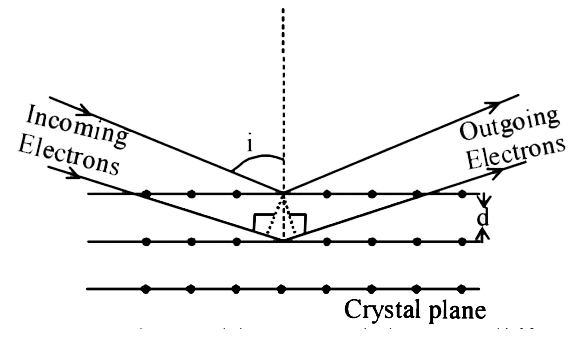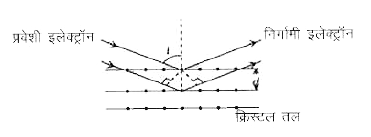Wave property of electrons implies that they will show diffraction effects. Davission and Germer demonstrated this by diffracting electrons from crystals. The law governing the diffraction from a crystal is obtained by requiring that electron waves reflected from the planes of atoms in a crystal interfere constructively (see figure)
_E01_233_Q01.png)
The surface of a metal is illuminated with the light of . The kinetic energy of the ejected photoelectrons was found to be . The work function of the metal is : ()Solution in Gujrati
The correct Answer is:D
By solving it
Topper's Solved these Questions
- SIMPLE HARMONIC MOTIONBOOK - ALLEN CHAPTER - SIMPLE HARMONIC MOTIONEXERCISE - Exercise-05 [A]
39 Videos
- SIMPLE HARMONIC MOTIONBOOK - ALLEN CHAPTER - SIMPLE HARMONIC MOTIONEXERCISE - Exercise-05 [B]
12 Videos
- SIMPLE HARMONIC MOTIONBOOK - ALLEN CHAPTER - SIMPLE HARMONIC MOTIONEXERCISE - Exercise-04 [A]
20 Videos
- RACEBOOK - ALLEN CHAPTER - RACEEXERCISE - Basic Maths (Wave Motion & Dopplers Effect) (Stationary waves & doppler effect, beats)
25 Videos
- TEST PAPERBOOK - ALLEN CHAPTER - TEST PAPEREXERCISE - PHYSICS
4 Videos
Similar Questions
If a spring has time period T, and is cut into (n) equal parts, then the time period of each part will be.
View SolutionA particle of mass (m) is executing oscillations about the origin on the x axis. Its potential energy is V(x)=k|x|3 where k is a positive constant. If the amplitude of oscillation is a, then its time period (T) is.
View SolutionA particle simple harmonic motion completes 1200 oscillations per minute and passes through the mean position with a velocity 3.14ms−1. Determine displacement of the particle from its mean position. Also obtain the displacement equation of the particle if its displacement be zero at the instant t=0.
View SolutionThe frequency of a radar is 780 MHz. After getting reflected from an approaching aeroplane, the apparent frequency is more than the actual frequency by 2.6 kHz. The aeroplane has a speed of
View SolutionChoose the correct statement:
View SolutionWave property of electron implies that they will show diffraction effected . Davisson and Germer demonstrated this by diffracting electron from crystals . The law governing the diffraction from a crystals is obtained by requiring that electron waves reflected from the planes of atoms in a crystal inter fere constructiely Electron accelerated by potential V are diffracted from a crystal if d = 1 Å and i = 30^(@), V should be about (h = 6.6 xx 10^(-34) Js, m_(e) = 9.1 xx 10^(-31) kg , e = 1.6 xx 10^(-19)C)
View SolutionWave property of electron implies that they will show diffraction effected . Davisson and Germer demonstrated this by diffracting electron from crystals . The law governing the diffraction from a crystals is obtained by requiring that electron waves reflected from the planes of atoms in a crystal inter fere constructiely

If a strong diffraction peak is observed when electrons are incident at an angle i from the normal to the crystal planes with distance d between them (see fig) de Brogle wavelength λdB of electrons can be calculated by the relationship (n is an intenger)
View SolutionWave property of electrons implies that they will show diffraction effects. Davission and Germer demonstrated this by diffracting electrons from crystals. The law governing the diffraction from a crystal is obtained by requiring that electron waves reflected from the planes of atoms in a crystal interfere constructively (see figure) In an experiment, electrons are made to pass through a narrow slit of width 'd' comparable to either de-Broglie wavelength. They are detected on a screen at a distance 'D' from the slit The following graphs that can be expected to represent the number of electrons 'N' detected as a function of the detector position 'y' ( y=0 corresponds to the middle of the slit) is
View SolutionIn Davisson and Germer experiment, a crystal which diffracts a beam of electrons is of
View SolutionIn Davission and Geremer experiment, an electron beam is incident on a crystal. In the diffracted beam there are
View SolutionDirection : Question Numbers. 150 and 151 are based on the following paragraph.
Wave property of electrons implies that they will show diffraction effects. Davisson and Germer demonstrated this by diffracting electrons from crystals. The law governing the diffraction from a crystal is obtained by requiring that electron waves reflected from the planes of atoms in a crystal interfere constructively (See figure).

Electrons accelerate by potential V are diffracted from a crystal. If d=1Å and i=30∘, V should be about (h=6.6×10−34Js,me=9.1×10−31kg,e=1.6×10−19C)
View SolutionDirection : Question Numbers. 150 and 151 are based on the following paragraph. Wave property of electrons implies that they will show diffraction effects. Davisson and Germer demonstrated this by diffracting electrons from crystals. The law governing the diffraction from a crystal is obtained by requiring that electron waves reflected from the planes of atoms in a crystal interfere constructively (See figure). If a strong diffraction peak is observed when electrons are incident at an angle i from the normal to the crystal planes with distance d between them (see tigure), de-Broglie wavelength lamda_(dB) of electrons can be calculated by the relationship (n is an integer)
View SolutionA fast moving bullet is not diffracted by a crystal surface, while an electron diffracts. Why?
View SolutionThe wave property of electrons implies that they will exhibit diffraction effects. Davison and Zermer demonstrated this by diffraction of electrons from Christlow. The regulatory law of diffraction from a crystal is derived from the rich interference of the reflected electron waves from the plane of the atoms in the crystal. With the help of the above, choose the most appropriate answer to the following questions. Electrons accelerated by the V potential are reversed from the crystal. If d = 1Å and i = 30^(@) So V should be around this much (h = 6.6 xx10^(-34) J s , m = 9.1 xx10^(-31) kg , e = 1.6 xx10^(19) C)
View SolutionThe wave property of electrons implies that they will exhibit diffraction effects. Davison and Zermer demonstrated this by diffraction of electrons from Christlow. The regulatory law of diffraction from a crystal is derived from the rich interference of the reflected electron waves from the plane of the atoms in the crystal. With the help of the above, choose the most appropriate answer to the following questions. If a strong diffraction peak is seen when the electrons are on the crystal bottom, between which the distance d is incident with the wavelength, then the de Broglie wavelength of the electrons is de Broglie. lambda _(dB) Can be deduced from this equation (n is an integer)
View Solutionइलेक्ट्रॉन के तरंग गुण में यह अंतर्निहित है कि ये विवर्तन प्रभाव दर्शाएगें। डेवीसन तथा जर्मन ने इसे क्रिस्टलों द्वारा इलेक्ट्रॉनों को विवर्तित करके निर्देशित किया। क्रिस्टलों द्वारा इलेक्ट्रॉनों के विवर्तन की व्याख्या करने वाले नियम भी इस तथ्य पर आधारित है कि किसी क्रिस्टल में परमाणुओं के तलों से परिवर्तित इलेक्ट्रॉन तरंगों का संपोषी व्यक्तिकरण होता है आरेख दिखिए)।

जब 'd' दूरी के क्रिस्टल तलों (आरेख दिखिए) के अभिलंब से 'i' कोण पर इलेक्ट्रॉनों के आपतन से कोई प्रबल विवर्तन शिखर प्रकट होता है, तो इलेक्ट्रॉनों की डी - ब्रोग्ली तरंग दैर्ध्य λdB के परिकलन के लिए उपयोग किया जाने वाला संबंध है (यहां n एक पूर्णांक है )
View Solution
